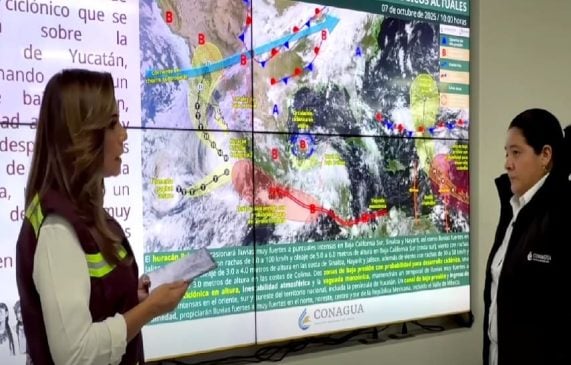Riviera Maya, Mexico — Potential cyclone ONE has officially developed into a named storm. Alberto, which is the first name on the Atlantic hurricane season list, has been given to the system that has been brewing in the Gulf of Mexico since June 12.
On Wednesday morning, the NOAA named the first storm of the season as it continues its west-northwest trajectory toward land. At the time of naming, the center of the storm was located 250 km east-northeast of Cabo Rojo, Veracruz and 300 km east of Tampico, Tamps.
Alberto has maximum sustained winds of 65 km/h, gusts of 85 km/h with westward movement at 15 km/h. Its wide circulation is forecast to generate intense rains (75 to 150 mm) and wind gusts of 70 to 90 km/h, lightning, possible hail, as well as the formation of waterspouts and waves of 1 to 3 meters high in Quintana Roo.
According to the National Hurricane Center ,“Alberto is on a westward motion and an increase in forward speed is expected through Thursday. On the forecast track, the center of Alberto will reach the coast of northeastern Mexico early Thursday morning.
“Maximum sustained winds are near 40 mph (65 km/h) with higher gusts. Some slight strengthening is forecast today or tonight before the center of Alberto reaches land. Rapid weakening is expected once the center moves inland, and Alberto is likely to dissipate over Mexico Thursday or Thursday night.
“Tropical Storm Alberto is expected to produce rainfall totals of 5 to 10 inches across northeast Mexico into South Texas. Maximum totals around 20 inches are possible across the higher terrain of the Mexican states of Coahuila, Nuevo Leon, and Tamaulipas.”
Storm surge watches are in effect for Sargent, TX to Sabine Pass, Texas, Galveston Bay, Mouth of the Rio Grande, Texas to Sargent and Sabine Pass, TX to Vermilion/Cameron Parish Line, LA, the NOAA has reported.
Tornadoes are possible today and tonight across parts of Deep South Texas and Southeast Texas. The NOAA says swells generated by Alberto will affect the coast of Texas and northeastern Mexico through Friday.
This same system has been responsible for the torrential rains that have plagued Quintana Roo since Friday night. On Monday night, the city of Cancun recorded 165 mms of rain in 10 hours. Cancun residents woke up Tuesday morning to 70 flooded areas.


